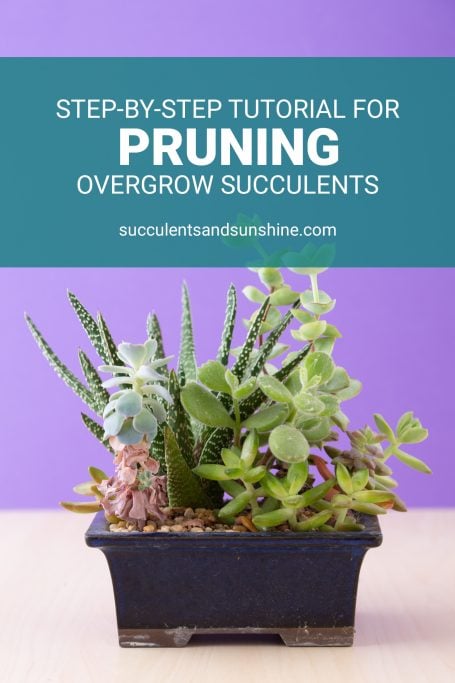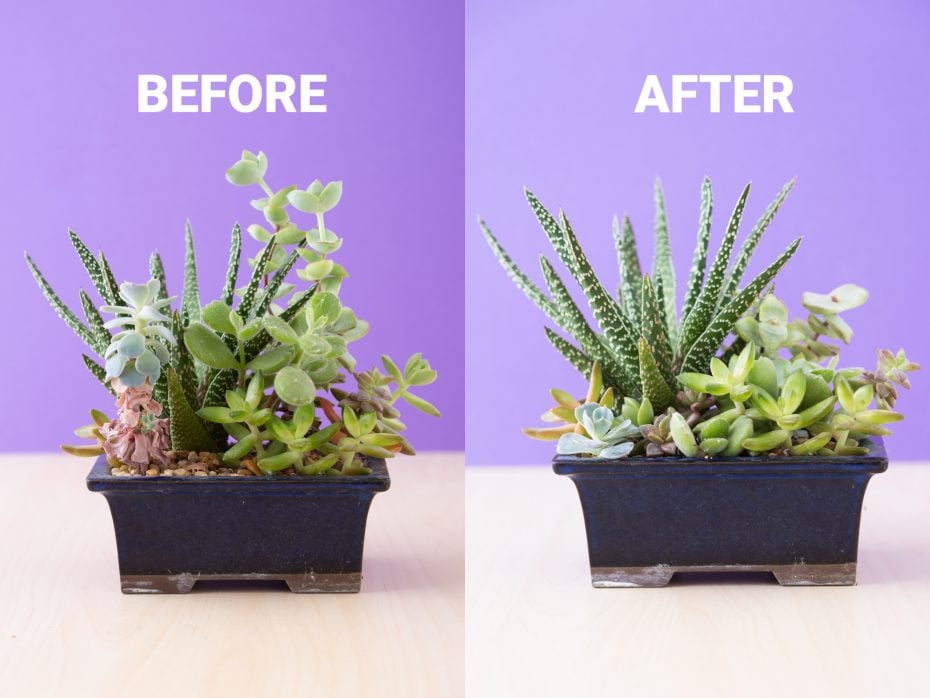Occasionally trimming your succulents can help them thrive. This can prevent disease, promote new growth, and extend their lifespan. Discover the best ways and times to prune your succulents now!
When you purchase something through this website, we may receive a commission which doesn’t cost you any extra money. This allows us to offer free content for you to experience.
After caring for succulents for some time, a transformation occurs that is quite remarkable.
They expand!
Despite the fact that succulents are slow-growing plants, people are often taken aback when their neat and tidy succulent arrangement no longer looks presentable. This is because succulents eventually outgrow the pots they are planted in, and need regular maintenance to stay looking neat.
Taking care of succulents doesn’t have to be hard, but there are a few tips that can make the process easier. In the end, I’ll reveal my special trick to give your succulent arrangement a fresh and new look.
You can get even more assistance by downloading my complimentary cheat sheet. It’s a great resource to check if your succulents need more or less water. Just click the link and you’ll be all set!
In spring and fall, it is a good idea to take some time to assess your succulent arrangements and do some tidying up. Pruning and cleaning are especially beneficial during the spring season.
In the autumn season, it is best to keep the arrangements in your garden as is. Clear away any dead leaves and debris, but wait until the spring season to replant, behead, and propagate.
If you’re feeling confused by any of the information in this post, don’t worry! I’m going to explain everything step-by-step.
Table of Contents
Regular maintenance
Eventually, the leaves at the bottom of your succulent will wither and perish. This is a normal, expected part of its life cycle, and there’s no need to worry.
Removing some of the leaves from your succulent from time to time will result in the best growth for the plant. Leaving them on the stem for too long can make it more difficult for the soil below the plant to dry out, leading to the potential for the plant to start decaying.
Take your fingers and delicately pluck off the dead leaves. You may see some fresh sprouts on the stem, which is great news. Discarding the old leaves may help foster the appearance of new growth along the stem.
Be sure to clear away any obstructions from between your plants. This is especially critical if they are outdoors, as wind may bring in leaves or twigs that could potentially attract pests.
It is important to routinely clear away dead leaves and other debris, but at a minimum, you should do it in both the spring and autumn seasons.
When to prune
Succulents can be pruned even outside of the beginning of their growing season, though you may not notice new growth as soon as you would have if you pruned at the start. However, the plants will continue to grow slowly and pick up again when they begin actively growing.
Check out the dormancy table to determine when your succulents are in their active growing period, as there are some succulents that thrive during the winter months in addition to the more popular summer growers.
I usually trim my succulents in the spring after they have been inside during the winter. They usually become elongated and don’t look as good as they did before.
Pruning the plants I already have is a great way to change up my garden without having to purchase more. It’s an economical and effective way to get more out of my existing plants.
Tools for Pruning
The key to successful pruning is having the right tool for the job. I recommend using bonsai scissors since they are sharp and lightweight, making them easy to handle and efficient. Additionally, make sure your scissors or shears are clean prior to pruning in order to avoid any potential diseases from affecting your succulents.
tape, glue, and paper.
I usually have more than just scissors available when I’m working; I also keep tape, glue, and paper nearby.
- Long-handled tweezers for plucking out dead foliage from awkward spots; a towel for wiping away soil and dirt from my hands and work surface; a chopstick for loosening soil and making openings for new plants (Bonsai Jack includes one with every soil purchase); and my cactus catch-all tray for collecting leaves and cuttings to propagate. Plus, I always keep a few succulent cuttings on hand in case I need to fill some gaps.
Beheadding succulents
At the front, the Echeveria was noticeably tall and spindly. At the back, the Crassula perforata and Cotelydon tomentosa had become unruly. I used this great pair of scissors to snip off the tops of the Echeveria and the Crassula perforatas.
It’s important to give the cuttings time to dry out before replanting them to avoid rot. Therefore, I suggest that you make all the cuts you need in one go and then wait at least a day before replanting them.
I chose to take out the tall Echeveria plant because its bare stem was very visible in the arrangement, even though it would eventually sprout new growth.
I placed it in what Laura Eubanks has dubbed my “Garden of Death,” a place where succulents can either thrive or perish, depending on their own efforts. When the plant produces new rosettes, I will either give it a permanent home or continue to harvest cuttings from it.
Be sure to grab any healthy leaves that fall off the plant, as these can be used to propagate new plants. This is a great way to get free plants, which is always a plus!
Removing dead plants
I removed the Cotelydon tomentosa due to its leggy appearance, snipping off the top first. Unfortunately, the base plant was not faring well, so I uprooted it from the soil. Additionally, I removed a Crassula perforata located beside it as it was not thriving.
Replant the cuttings
After your cuttings have been allowed to dry for about 24 hours, you can replant them in the arrangement. Complete the look by filling in any empty spaces where plants were removed. I prefer to plant my arrangements closely together as this helps to slow down the growth rate, allowing the arrangement to remain “neat” for a longer period of time.
When I’m working with cuttings, I always make sure the stems are straight. If the cutting has a curved end, I cut it off and let it dry for at least one day before placing it in the soil.
My secret weapon… top dressing!
You don’t have to limit yourself to just the cuttings from the original arrangement; if there are any gaps, you can easily fill them in with cuttings from another arrangement or rooted succulents. There are no hard and fast rules here!
The next step is to complete the assemblage by incorporating a top dressing. If you have no idea what a top dressing is, be sure to check out this article for more information.
In other words, top dressing is a decorative rock used to give an arrangement a finished and polished appearance. It is a great way to improve the look of a garden or floral display after pruning if it is still not quite right.
Check out the video to witness how much of an improvement came from getting rid of dead foliage and adding top dressing to these arrangements.
Check the arrangement one last time to see if any additional plants or other touches are needed to perfect it, then proceed.
You have finished!
Your arrangement is now looking its best again! Allow the roots and plants to settle and heal for at least one day by not giving them any additional water.
When it’s watering time, utilize the soak-and-dry procedure to guarantee your arrangement remains healthy. Keep giving it brilliant, diffused light and it will keep on thriving for a few more months or a year before needing pruning again.
If you pay close attention to your succulents, you’ll be able to tell when they require a bit of care. This way, you’ll be able to give them the right treatment.
If you haven’t already, be sure to get my free cheat sheet to learn how to tell when your succulents need more or less water. Click here for the cheat sheet.
FAQ
How do you prune hanging succulents?
This video shows a woman who is singing about how she will never forget the love she once had for someone. She expresses how hard it is to move on from the pain of a past relationship, but she will do her best to keep on going.
How do you maintain a succulent arrangement?
This video is about a group of kids learning the basics of coding. They are shown how to create a simple animation using a program called Scratch. They use instructions to build their own game and then get to play it. This clip highlights the importance of coding and how it can be used to create interactive programs.
Should you cut stalks off succulents?
Succulents can be propagated by pruning them. To ensure healthy growth, it is important to cut off any diseased, dead, or broken stems, flowers stalks, and leaves, as these plants are able to seal off the trimmed points.
Can you trim hanging succulents?
You can prune succulents at any time, but if you do it at the beginning of their growth period, you will see quick results. If you wait until the end of the growing season, the plants won’t produce new growth as quickly, but it will eventually start again when they start to actively grow again.
How do you prune trailing succulents?
Cut a 45-degree angle into the stem of the succulent about a half-inch away from the leaf or node you wish to remove. Use a sharp, clean knife to cut off up to one-third of the stem length. This will give the plant a more pleasing look, depending on the specific type of succulent.


